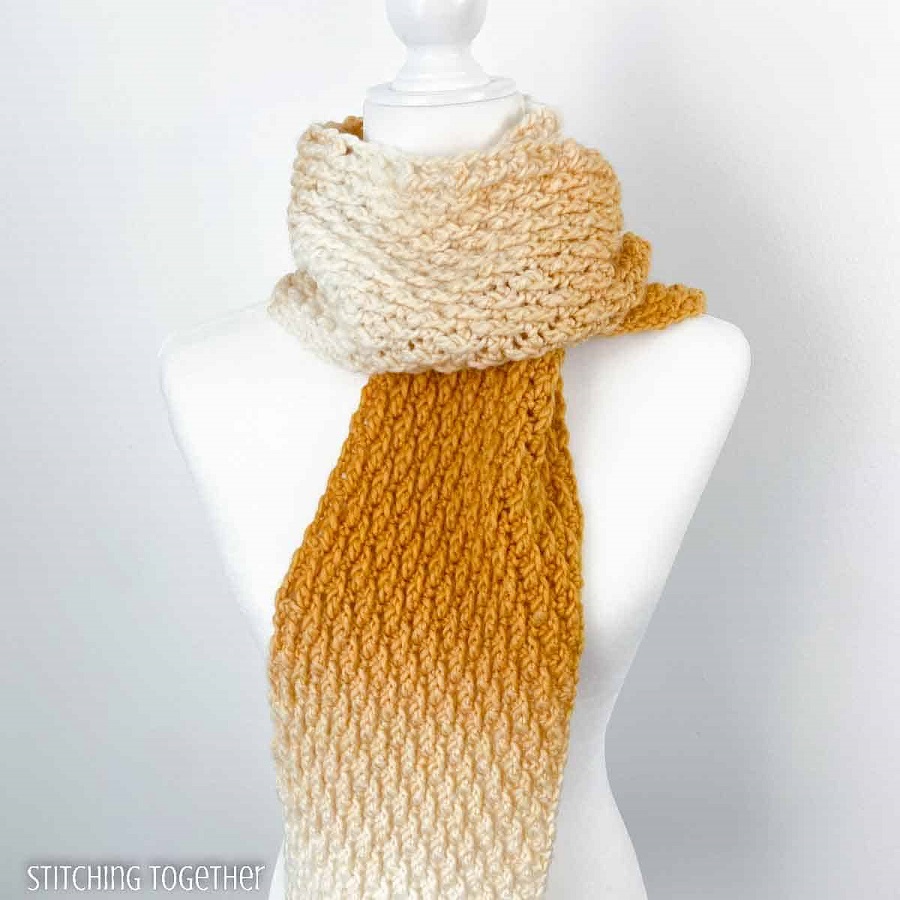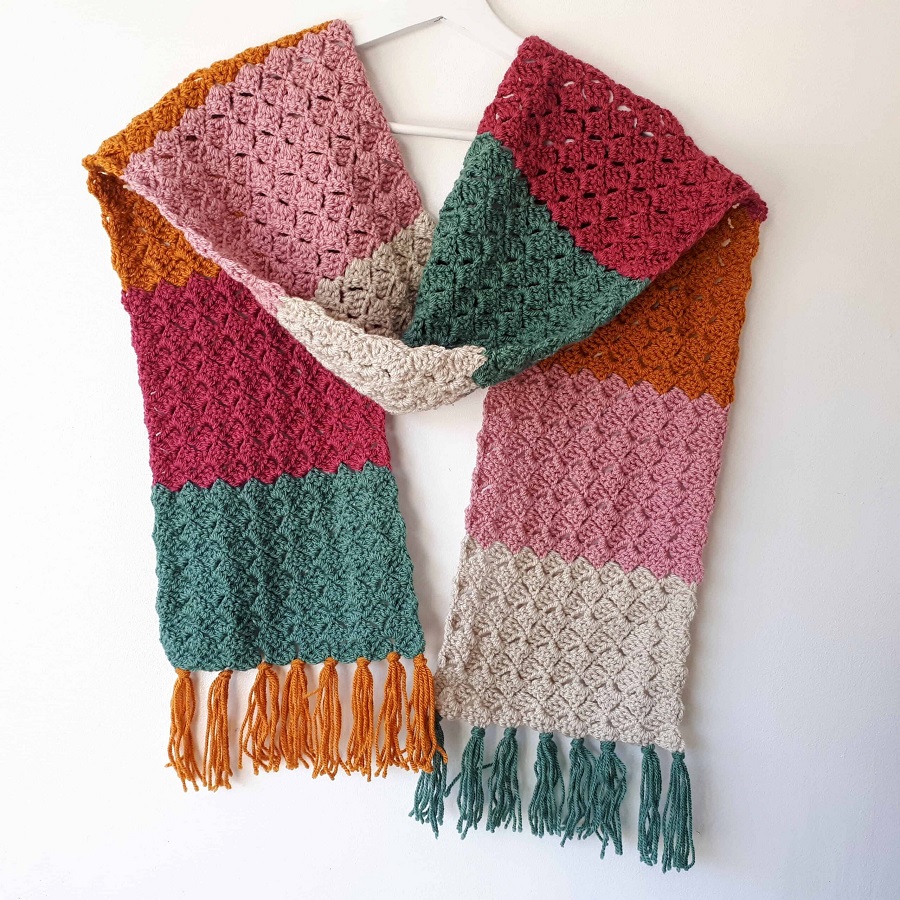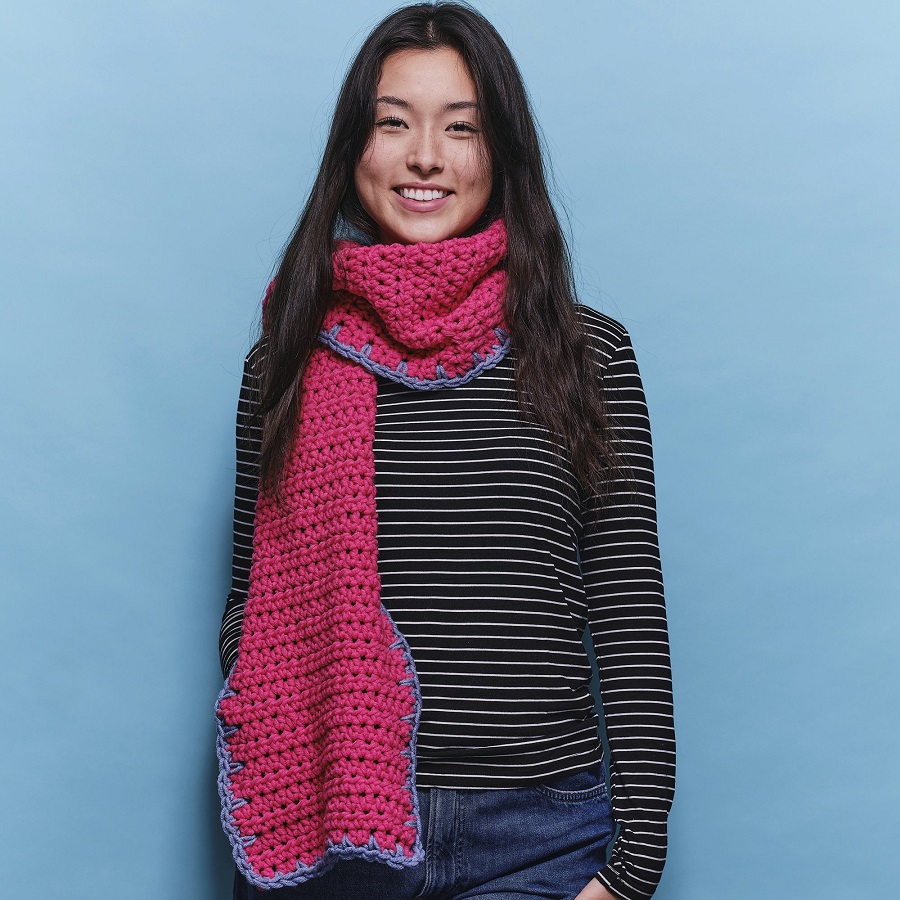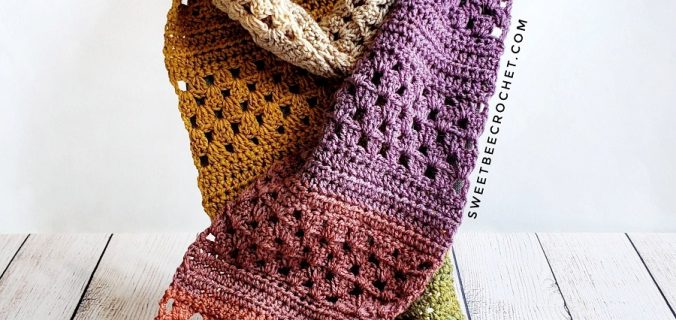Introduction to Crochet and Scarf Making
Crochet a scarf – Crocheting is a versatile textile craft involving looping yarn with a crochet hook. This technique can create various items including the popular and cozy scarf. Crocheting a scarf is an excellent project for beginners. It requires basic skills and few materials, making it accessible and enjoyable. Scarf making allows for creativity and personalization, from selecting the yarn to choosing the design. Whether you are new to crochet or looking to refresh your skills, making a scarf can be a fulfilling endeavor. This section will guide you through the fundamentals of crochet and the specifics of scarf making.

Essential Crochet Materials and Tools
Before you begin to crochet a scarf, gathering the right materials and tools is crucial for a smooth and enjoyable crafting experience. Here’s what you’ll need to start your project:
- Crochet Hook: Hooks come in various sizes. Choose one that matches the recommended size for your yarn. The size can influence the scarf’s drape and density.
- Yarn: Yarn can range from lightweight to super bulky. For scarves, medium-weight yarn is often preferred for its warmth and manageability.
- Scissors: A pair of sharp scissors is necessary for cutting yarn as you work or when you’ve finished your project.
- Yarn Needle: This needle helps weave in ends to give your scarf a neat finish. Opt for a blunt tip to avoid splitting the yarn.
- Stitch Markers: These can be helpful for marking your progress or noting special stitches to refer back to.
- Measuring Tape: Essential for measuring your scarf to ensure it reaches your desired length.
- Crochet Pattern: A pattern will guide your stitching and help you create the scarf’s design. Make sure you understand it before starting.
These tools and materials form the foundation of your crocheting toolkit. Once you have these, you’re all set to commence your scarf-making journey.
Selecting the Right Yarn for Your Scarf
Choosing the right yarn is crucial to crochet a scarf that meets your needs. The yarn you select will determine the texture, warmth, and overall look of your finished scarf. When selecting yarn, consider the following factors:
- Fiber Content: Yarns come in various fibers such as wool, cotton, acrylic, and blends. Wool is warm and durable, while cotton offers a cooler feel. Acrylic is a budget-friendly option that is easy to care for.
- Weight and Thickness: The weight of the yarn will affect the thickness of your scarf. Lighter weights are suited for delicate scarves, while heavier weights offer more warmth.
- Color: Color can set the tone of your scarf. It can be a single hue or a blend of colors for a more complex look. Make sure the color complements your style.
- Texture: Smooth yarns provide a cleaner look, while textured yarns add interest and dimension to your scarf.
- Washability: Consider if the yarn can be easily washed and cared for. This is important for maintenance over time.
Take the time to touch and feel the yarn, if possible. The softness will contribute to the comfort of your scarf. By considering these factors, you’ll be on the right track to crochet a scarf that you’ll love to wear and share.
Basic Crochet Stitches for Scarves
In the journey to crochet a scarf, mastering some basic stitches is key. These stitches form the foundation of most scarf patterns. Here are a few you should know:
- Chain Stitch (ch): This is the very first stitch you’ll make. It forms the base of your work.
- Single Crochet (sc): A simple, compact stitch that creates a dense fabric, perfect for warm scarves.
- Double Crochet (dc): This stitch is taller and creates a more open, airy fabric. It’s quicker to work up.
- Half Double Crochet (hdc): It’s a middle ground between a single and double crochet, offering a bit of both their qualities.
- Slip Stitch (sl st): Often used for joining pieces together or creating borders, this stitch is useful for finishing.
These stitches can be combined in various ways to create textures and patterns in your scarf. To begin, practice each stitch until you feel comfortable with their execution. Remember to keep your tension even to ensure a uniform look throughout your scarf. Once mastered, you’ll be able to tackle more complex designs with confidence.
Your scarf’s thickness, texture, and overall appearance will depend on the stitches you choose. Experiment with different stitches to find the look and feel you prefer. Crocheting a scarf offers the perfect opportunity to practice and perfect these fundamental stitches. As you gain proficiency, your handmade scarves will not only look better but will also become more enjoyable to create.
 Reading and Understanding Crochet Patterns
Reading and Understanding Crochet Patterns
Understanding crochet patterns is vital when you crochet a scarf. Patterns serve as blueprints that guide you through the crocheting process. Here are key elements to focus on when reading crochet patterns:
- Pattern notations: Familiarize yourself with the abbreviations and symbols used, such as ‘ch’ for chain stitch and ‘dc’ for double crochet.
- Gauge: This indicates how many stitches and rows per inch you should have. It ensures your scarf dimensions are correct.
- Skill level: Patterns usually specify if they’re for beginners, intermediate, or advanced crocheters.
- Description of Work: Patterns provide instructions on how to start, the order to follow, and how to finish each section.
- Stitch counts: At the end of a row or round, patterns often list the number of stitches you should have. This helps you ensure accuracy in your work.
To effectively use a crochet pattern, read through it before you start crocheting your scarf. Understand each section to minimize mistakes. As you become more experienced, reading and following these patterns will become easier and more instinctive. Crochet a scarf successfully by mastering the ability to follow these patterns closely.
Crocheting Your First Scarf: The Process
So you’re ready to crochet a scarf. The process is straightforward but requires patience and practice. Let’s walk through the basic steps to get you started on your scarf-making journey. Remember, this is just a framework. Feel free to get creative within these guidelines as you become more comfortable.
- Start with a Slip Knot: Create a slip knot on your crochet hook to begin.
- Make the Foundation Chain: Depending on the pattern and width, crochet a chain that will serve as the backbone of your scarf.
- Begin the First Row: Use the basic stitches you’ve learned, like the single crochet (sc), to start your first row.
- Work the Pattern: Continue with the pattern, which could vary in stitches from one row to another.
- Keep the Row Count: Keep track of the rows and your overall length to ensure evenness.
- Ending Your Scarf: Once you’ve reached the desired length, cut the yarn, leaving a tail for weaving.
- Weave in Ends: Use the yarn needle to weave in the ends for a clean finish.
By following these steps and keeping your stitches even, you’ll create a simple and beautiful scarf. Go slowly, and don’t be afraid to undo and redo sections as needed. Patience is key when you crochet a scarf. Each row you crochet will get you closer to a handmade accessory you can be proud of.
Finishing Touches: Edging and Blocking Your Scarf
Once you crochet a scarf, the final steps are edging and blocking. These give your scarf a professional, polished look. Let’s dive into these important finishing touches.
Edging Your Scarf
Edging can define your scarf’s borders, adding elegance or a fun twist. Here’s how to add an edging:
- Choose an Edging Pattern: Pick a simple or decorative border. Patterns range from basic single crochet edgings to intricate lace.
- Attach Yarn to a Corner: Using a slip stitch, attach your yarn to any corner.
- Work Around the Scarf’s Edges: Crochet the edging pattern all around your scarf’s sides.
- Secure and Finish Off: Once complete, cut the yarn and weave in ends securely.
Edging is not mandatory but can enhance the scarf’s look and durability. A well-crocheted edging can prevent your scarf from stretching out.
Blocking Your Scarf
Blocking defines the shape and size of your crocheted scarf. Here’s how to block your scarf effectively:
- Wash the Scarf Gently: Clean it following the yarn’s washing instructions.
- Remove Excess Water: Roll the scarf in a towel and press to absorb water.
- Layout the Scarf: On a flat, moisture-resistant surface, spread your scarf to its desired dimensions.
- Pin the Scarf: Use rust-proof pins to hold the scarf in place. Pin along the edges, shaping as you go.
- Let it Dry: Allow your scarf to air dry completely without heat.
Blocking can improve the drape and appearance of your scarf. It’s a key step if you want your project to look its best.
With edging and blocking done, your handmade scarf is ready to wear or gift. These final touches bring out the beauty of your work, showcasing your effort and skill.
Maintenance and Care for Crocheted Scarves
Once you have completed the journey to crochet a scarf, maintaining its beauty and shape over time is essential. Here’s how you can care for your crocheted scarves to ensure they stay cozy and attractive year after year:
- Follow Washing Instructions: Adhere to the yarn label’s guidance for washing. Some yarns may require hand washing or a gentle cycle in the machine.
- Use Mild Detergent: Opt for a detergent that is suitable for delicate fabrics to keep the yarn soft and vibrant.
- Avoid High Heat: High temperatures can damage fibers, so always use cold water and avoid the dryer. Dry your scarf by laying it flat.
- Reshape While Damp: After washing, gently stretch your scarf to its original dimensions. This will help it maintain its shape as it dries.
- Store Properly: Keep your scarf in a cool, dry place. Fold it neatly or roll it to prevent creases and preserve its form.
- Protect from Pests: Store with natural repellents like cedar blocks to safeguard against moths and other pests that could harm the yarn.
With proper care, your crocheted scarf will remain a beloved addition to your wardrobe or a heartwarming gift for someone special. Remember, a little attention goes a long way in keeping your handcrafted treasure looking its best.
 Troubleshooting Common Crochet Issues
Troubleshooting Common Crochet Issues
When you crochet a scarf, you may encounter a few common issues. Here’s how to solve them effectively.
- Uneven Edges: Ensure you’re counting your stitches correctly. Always mark the first and last stitch of each row.
- Twisted Chain: Prevent this by laying your chain flat before the first row. Take care not to rotate it.
- Loops Too Tight or Loose: Keep consistent tension throughout. Practice holding your yarn and hook comfortably.
- Stitches Dropping: Insert your hook fully into loops to catch them properly. If a stitch does drop, use a crochet hook to pull it through.
- Yarn Splitting: Use a blunt-tip yarn needle and be gentle as you weave in ends. Consider a thicker or higher-quality yarn.
- Color Transitions Looking Messy: Change yarn at the end of a row, not mid-row. Secure ends well.
By addressing these common issues, you’ll improve your crocheting skills and end up with a scarf to be proud of.
